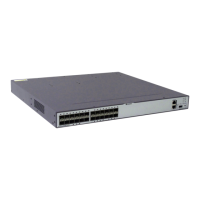Pre-configuration Tasks
To configure a Route-Policy, complete the following tasks:
l 10.3 Configuring the IP-Prefix List
l Configuring routing protocols
Data Preparation
To configure a Route-Policy, you need the following data.
No. Data
1 Name and node number of the Route-Policy
2 Matching rule
3 Route attributes to be modified
10.4.2 Creating a Route-Policy
By applying a Route-Policy, you can set attributes for the imported routes according to
networking requirements.
Context
Do as follows on the switch to which the Route-Policy is applied:
Procedure
Step 1 Run:
system-view
The system view is displayed.
Step 2 Run:
route-policy route-policy-name { permit | deny } node node
A node of the Route-Policy is created and the Route-Policy view is displayed.
l The parameter permit specifies a node in a Route-Policy in permit mode. If a route matches
the node, the switch performs actions defined by the apply clauses and the matching is
complete. Otherwise, the route continues to match the next nod.
l The parameter deny specifies a node in a Route-Policy in deny mode. In deny mode, the
apply clauses are not used. If a route entry matches all the if-match clauses of the node, the
route is denied by the node and the next node is not matched. If the entry does not match all
the clauses, the next node is matched.
NOTE
In the S6700, by default, the unmatched routes are denied. If multiple nodes are defined in a Route-Policy,
at least one of them should be in permit mode.
When the parameter route-policy is used to filter routes, note the following:
S6700 Series Ethernet Switches
Configuration Guide - IP Routing 10 Routing Policy Configuration
Issue 01 (2012-03-15) Huawei Proprietary and Confidential
Copyright © Huawei Technologies Co., Ltd.
598

